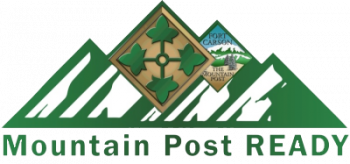1SBCT History
 The 1st Stryker Brigade Combat Team, 4th Infantry Division, is comprised of six subordinate units including the 4th Battalion, 9th Infantry Regiment; 2nd Battalion, 23rd Infantry Regiment; 1st Battalion, 38th Infantry Regiment; 2nd Battalion, 12th Field Artillery Regiment; 299th Brigade Engineer Battalion; and the 4th Brigade Support Battalion.
The 1st Stryker Brigade Combat Team, 4th Infantry Division, is comprised of six subordinate units including the 4th Battalion, 9th Infantry Regiment; 2nd Battalion, 23rd Infantry Regiment; 1st Battalion, 38th Infantry Regiment; 2nd Battalion, 12th Field Artillery Regiment; 299th Brigade Engineer Battalion; and the 4th Brigade Support Battalion.
The “Raider” Brigade was constituted Nov. 19, 1917, in the Regular Army as Headquarters Troop, 4th Infantry Division. The unit participated in World War I and was involved in numerous campaigns including Aisne-Marne, St. Mihiel, Meuse-Argonne, Champagne and Lorraine. It reorganized July 6, 1942, as Headquarters Company, 4th Infantry Division, in preparation for the initial assault into Normandy. Following the end of World War II, the unit was inactivated March 12, 1946, at Camp Butner, North Carolina. The Raider Brigade served in Vietnam operating in numerous operations and counteroffensives.
On Oct. 15, 1995, the brigade inactivated at Fort Carson, Colorado, but was reactivated at Fort Hood, Texas, Jan. 16, 1996. In March 2003, the Raider Brigade deployed to Iraq in support of Operation Iraqi Freedom. On Dec. 13, 2003, 600 Raider Brigade Soldiers, along with Special Operations Forces, launched Operation Red Dawn, which resulted in capturing the former Iraqi President Saddam Hussein. The Raider Brigade was reorganized and redesignated as the 1st Brigade Combat Team, 4th Infantry Division, in 2004. The Raider Brigade returned to Iraq in January 2006 fulfilling the second deployed rotation in support of Operation Iraqi Freedom.
The Raider Brigade deployed for a third time in March 2008, to southern Baghdad during the peak of sectarian violence. After successful provincial elections in January 2009, the Raider Brigade returned to Fort Hood in March 2010. In the summer of 2009, the Raider Brigade relocated from Fort Hood, Texas, to Fort Carson, Colorado. In September 2009, the brigade received orders as the first heavy brigade combat team to deploy to Afghanistan in support of Operation Enduring Freedom. The brigade deployed July 2010 and operated in two regional commands in the south and west of Afghanistan. Combined Task Force Raider fought and trained side by side with the Afghan National Security Forces and International Security Assistance Forces partners from Herat and Farah to Kandahar and Arghandab. The Raider Brigade deployed February 2013 in support of Operation Spartan Shield in Kuwait. The majority of the unit was tasked as theater reserve and based out of Kuwait, while elements of the brigade operated with Security Forces North and South. The unit provided joint security and training operations between the Kuwaiti military forces as well as the Jordanian military.
In March 2014, the Raider Brigade began its conversion from an Armored Brigade to a Stryker Brigade Combat Team, trading in its M1 Abrams tanks and Bradley Infantry Fighting vehicles for the Stryker combat vehicles. The 1st Stryker Brigade Combat Team combines the capacity for rapid deployment with survivability and tactical mobility, enabling Soldiers to maneuver within the close confines of urban terrain, provide protection in open terrain, and transport infantry quickly to critical battlefield positions. Throughout 2015 and 2016, the Raider Brigade tested the Stryker combat vehicle through numerous training exercises. In 2017 and 2018, rotations to the National Training Center at Fort Irwin, California, and deployed in support of Operation Freedom’s Sentinel and Resolute Support Mission.
In September 2021, the Raider Brigade deployed to Kuwait, Iraq and Syria in support of Operation Inherent Resolve (OIR). During its deployment, the brigade faced a unique problem set with half the brigade being deployed forward and the other half building readiness at Fort Carson. Raiders maintained and improved operational readiness throughout the unit while staying ready to rapidly deploy and defeat the nation’s threats. Task Force Raider worked diligently alongside the Combined Joint Task Force (CJTF) to successfully complete its mission of deterring multi-national state and non-state actors within the region. All Raiders came together to accomplish both missions abroad and at home station.
In September 2024, the Raider Brigade de-activated 2nd Squadron, 1st Cavalry Regiment, in support of the Army’s Structure (ARSTRUC) force realignment.
The brigade earned numerous campaign participation credits, including Meuse-Argonne during World War I; Tet Counteroffensive and Pleiku Province in Vietnam; and Iraqi Governance as part of Operation Iraqi Freedom to name a few. A few of its more prestigious decorations include two Presidential Unit Citations, the Valorous Unit Award, the Army superior unit award, the Republic of Vietnam Cross of Gallantry with Palm, and the Belgian Fourragere.



 Family and Morale, Welfare & Recreation
Family and Morale, Welfare & Recreation

